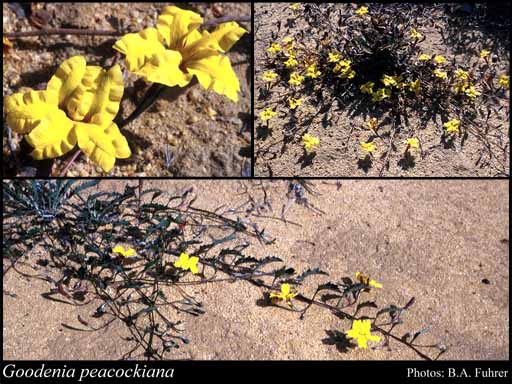- Reference
- Telopea 2:64-65 (1980)
- Conservation Code
- Not threatened
- Naturalised Status
- Native to Western Australia
- Name Status
- Current
Prostrate to decumbent annual, herb, 0.04-0.2 m high, to 0.9 m wide. Fl. yellow, Jun to Oct. Red sandy & loamy soils. Sandplains, stony hills.

Scientific Description
Stems unribbed. Leaves flat, 20-50 mm long, 8-20 mm wide, Indumentum absent (leaves glabrous); margins toothed. Bracteoles absent. Pedicel pedicellate, Pedicel length the pedicels 20-45 mm long, glabrous. Calyx lobes present, Calyx length 5-7 mm long, glabrous. Corolla yellow, 14-23 mm long, without auricles, not spurred, glabrous on the outside, hairy on the inside; central lobes 8.5-10 mm long, with wings; outer lobes 10-16 mm long, wing present on both sides and clearly unequal, 2-2.3 mm wide on the narrower side, 2.5-3 mm wide on the broader side. Anthers free. Ovary inferior, not gibbose; style 4.5-5.5 mm long, hairy; indusium single, hairy; ovules more than two. Flowers in June, July, August, September and October. Occurs in the Murchison (MUR), Great Victoria Desert (GVD), Coolgardie (COO), Central Ranges (CR), Gascoyne (GAS) and Gibson Desert (GD) IBRA Region(s), of the Eremaean (E) Botanical Province.
Distribution
- IBRA Regions
- Central Ranges, Coolgardie, Gascoyne, Gibson Desert, Great Victoria Desert, Murchison.
- IBRA Subregions
- Carnegie, Eastern Murchison, Lateritic Plain, Mann-Musgrave Block, Shield, Southern Cross.
- Local Government Areas (LGAs)
- Cue, Laverton, Leonora, Meekatharra, Menzies, Ngaanyatjarraku, Sandstone, Wiluna, Yilgarn.